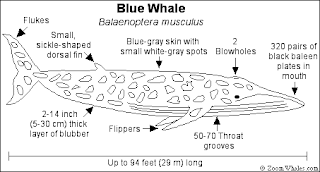Why was the whale so sad?

Because he was a blue whale!
By Jasmine ElliottThe Blue Whale is the largest animal ever known to exist. Although the largest recorded whale measured 110 feet the average Blue Whale ranges from about 80-100 feet. The females are usually about 10 feet longer than the males and a 100 foot whale tends to weigh around 200 tons (400,000 pounds).
The Blue Whale can mostly be found in cold and temperate waters and prefers deep oceans to coastal waters. They are most often known to migrate from the cooler waters where they feed to warmer more tropical areas to breed and give birth. Calves are usually born every 2-3 years and at approximately 8 meters long they are the the largest known baby on earth.
Here's a cool website where you can explore the ocean as a whale or even take revenge on whaling ships: Play Whale Games
Population and Geography
In the 20th century blue whales were relentlessly pursued by whaling fleets until they received world-wide protection in 1967. It is estimated that approximately 360,000 blue whales were killed in the Antarctic alone during the 20th century.
Blue whales truly have a global present but despite this distribution they are known to biologists as one of the rarest of the whales. The only place where their population has shown true recovery is in the eastern North Pacific off California where their umbers have reached close to 2,000.
Recovery Plan
According to the United States Fish and Wildlife Service website a Recovery Plan is defined as :
A document drafted by the Service or other knowledgeable individual or group, that serves as a guide for activities to be undertaken by Federal, State, or private entities in helping to recover and conserve endangered or threatened species.
Currently there are over 1,000 animal and plant species listed with active recovery plans in the U.S. alone. Each species can be listed as endangered or threatened. The Blue Whales recovery plan was listed on July 28, 1998 and blue whale was categorized as endangered.
Lets Talk Reasons
Blue whales are threatened by environmental changes including habitat loss, toxic chemicals, and climate change. Ship encounters and getting tangled in fishing nets are also factors in the endangerment of the species. But one of the main reasons for their original endangerment was the excessive hunting of these majestic creatures. Some of the main reasons whales were hunted was for:
- Oil: soap, perfumes and candles
- Food: Cooking oil, margarine and whale meat
- Clothing: corsets and umbrellas
- tools: fish hooks
What's the plan?
- Determine Stock Structure
- Estimate Population Size and monitor trends in abundance
- Identify and protect habitats essential to blue whale survival and recovery
- Reduce or eliminate human-caused injury and mortality
- Minimize detrimental effects of directed vessel interactions
- Maximize efforts to acquire scientific information from dead, stranded, and entangled blue whales
- Coordinate state, federal, and international efforts to implement recovery actions
- Establish criteria for delisting or down listing
Personal Action
With the implementation of this recovery plan there have been slight changes in the Blue Whales status. But the most important thing that we can do is to spread information about their status as threatened so people can start to effect change on a larger scale. for some more useful information on Blue Whales, their endangerment, and what you can do to help try checking out this website http://wwf.panda.org/what_we_do/endangered_species/cetaceans/about/blue_whale/
References
"Blue Whales." National Geographic. N.p., n.d. Web 29 Nov. 2015
National Marine Fisheries Service. 1998. “Recovery plan for the blue whale (Balaenoptera musculus).” Prepared By Reeves R.R., P.J. Clapham, R.L. Brownell, Jr., and G.K. Silber for the National Marine Fisheries Service, Silver Spring, MD. 42 pp.
"Blue Whale." WWF Global. World Wide Fund for Nature, 2015. Web. 25 Oct. 2015.

The blue background compliments your specie choice! This is really informative about the status of the blue whale and I also like that you included a link to an interactive game relating to whales. #BIO227Fall2015
ReplyDeleteThis comment has been removed by the author.
ReplyDeleteLove the blue background! It really makes your blog post stand out. The information is well organized and easy to read. Fantastic job!
ReplyDelete--Casey Garrett
#bio227Fall2015